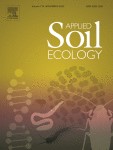Ver ítem
- xmlui.general.dspace_homeCentros e Institutos de InvestigaciónCIAP. Centro de Investigaciones AgropecuariasInstituto de Patología VegetalArtículos científicosxmlui.ArtifactBrowser.ItemViewer.trail
- Inicio
- Centros e Institutos de Investigación
- CIAP. Centro de Investigaciones Agropecuarias
- Instituto de Patología Vegetal
- Artículos científicos
- Ver ítem
Development of a soil quality index for sequences with different levels of land occupation using soil chemical, physical and microbiological properties
Resumen
The sustainable intensification of agricultural systems through crop rotations and/or the use of winter service crops can contribute to the diversification of the systems. This alteration of the surface layer creates conditions that favor an increase in the diversity of soil microbial communities, which improves the recovery capacity of the edaphic system, thereby contributing beneficial effects to plants, soil, and ecosystem. Our objectives were: 1) to
[ver mas...]
The sustainable intensification of agricultural systems through crop rotations and/or the use of winter service crops can contribute to the diversification of the systems. This alteration of the surface layer creates conditions that favor an increase in the diversity of soil microbial communities, which improves the recovery capacity of the edaphic system, thereby contributing beneficial effects to plants, soil, and ecosystem. Our objectives were: 1) to evaluate the effect of crops sequences on soil chemical, physical and microbial parameters, and 2) to develop a soil quality index (SQI) from a minimum set of indicators for cropping sequences with different levels of land occupation. A long field experiment under no-tillage was established in 2006, where soil samples were collected during three agricultural seasons (2015, 2016, and 2017). We compared the effects of four different crop sequences that included soybean (S), maize (M) and wheat (W), and also incorporated wheat as a winter cover crop (CC), being S-S, CC/S, M-W/S, and W/S-CC/M. We found that sustainable management practices, crop rotation and inclusion of CC increased soil organic carbon. The highest basic infiltration rate and lowest penetration resistance values were found for double-cropped wheat/soybean-winter cover crop/maize (W/S-CC/M), the most intensified sequence. The average microbial biomass carbon level for soybean monoculture, was reduced by 32 % compared to maize-double-cropped wheat/soybean in the three agricultural seasons, while the metabolic coefficient in soybean monoculture and winter cover crop/soybean was significantly higher. In soybean monoculture, hydrolysis of fluorescein diacetate was decreased by 28.5 %, while dehydrogenase activity was increased by 43 % with respect to double-cropped wheat/soybean-winter cover crop/maize. The abundance of fungal and bacterial communities did not reveal significant variations between sequences by quantitative PCR analysis. The SQI was constructed by selecting a minimum set of indicators based on soil chemical, physical and microbial parameters. The parameters selected by the model were soil organic carbon, total organic nitrogen, basic infiltration rate, microbial respiration and hydrolysis of fluorescein diacetate, that revealed the differences among crop sequences in response to land occupation. The inclusion of different crops increased the SQI in comparison with soybean monoculture. The double-cropped wheat/soybean-winter cover crop/maize system improved the SQI by 73 % compared to soybean monoculture. Our findings show that crop sequences with high soil occupation improved their chemical and physical properties, as well as increasing the abundance and functionality of the microbial community, which is related to a better SQI.
[Cerrar]

Autor
Fuente
Applied Soil Ecology 180 : 104621 (December 2022)
Fecha
2022-08-04
Editorial
Elsevier
ISSN
0929-1393
Documentos Relacionados
Formato
pdf
Tipo de documento
artículo
Proyectos
(ver más)
INTA/2019-PD-E2-I037-002/2019-PD-E2-I037-002/AR./Biodiversidad edáfica: componente clave para una gestión integral y sustentable del recurso suelo
Palabras Claves
Derechos de acceso
Restringido
 Excepto donde se diga explicitamente, este item se publica bajo la siguiente descripción: Creative Commons Attribution-NonCommercial-ShareAlike 2.5 Unported (CC BY-NC-SA 2.5)
Excepto donde se diga explicitamente, este item se publica bajo la siguiente descripción: Creative Commons Attribution-NonCommercial-ShareAlike 2.5 Unported (CC BY-NC-SA 2.5)

